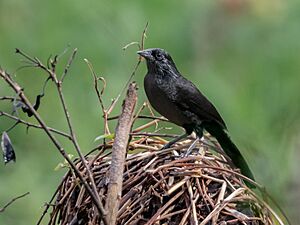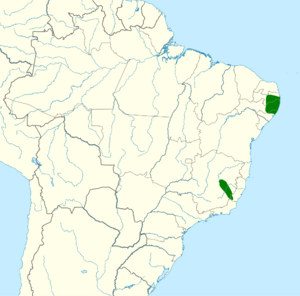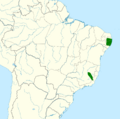Forbes's blackbird facts for kids
Quick facts for kids Forbes's blackbird |
|
|---|---|
 |
|
| Conservation status | |
| Scientific classification | |
| Genus: |
Anumara
|
| Species: |
forbesi
|
 |
|
| Synonyms | |
|
Curaeus forbesi |
|
The Forbes's blackbird (Anumara forbesi) is a special bird found only in the Atlantic Forest of South America. It is an endangered species of New World blackbird. This means there are not many of them left in the wild. The bird was named after a British zoologist named William Alexander Forbes.
Contents
What Does It Look Like?
The Forbes's blackbird is a medium-sized bird. It is about 21–24 cm long. All its feathers are black, but they are not shiny. It has a thin, arrow-shaped beak. The top of its beak, called the culmen, is straight. It is about as long as the bird's head.
This blackbird also has a long, thin tail. Its tail feathers are rounded. Like many birds that perch, it has three toes pointing forward. One toe points backward. This helps it grip branches. Its call sounds harsh and buzzy. It also makes chattering noises.
People sometimes confuse it with the chopi blackbird (Gnorimopsar chopi). But you can tell them apart! The chopi blackbird has shiny feathers. The Forbes's blackbird does not. Also, the chopi blackbird's beak has a clear curve. The Forbes's blackbird's beak is straight.
Life Cycle and Habits
The Forbes's blackbird usually lives for about 4.6 years. It eats mostly insects and fruit. Sometimes, it also sips nectar from flowers. It might even eat sugarcane.
Its breeding season is from March to June. This is during the rainy season. These birds often build their nests in mango trees. A female bird usually lays 1 to 4 eggs at a time. She can have up to two groups of eggs in one breeding season. After building a nest, it takes 4 to 10 days for her to lay eggs. Experts believe there are fewer than 10,000 adult Forbes's blackbirds left.
Where Does It Live?
The Forbes's blackbird does not migrate. It stays in the same area all year. You can find it in eastern and northeastern Brazil. Its home is split into many small areas.
It lives in different places. These include moist lowland forests. It also likes grasslands that get wet or flooded. Sometimes, it lives in plantations, like sugar cane fields. The biggest group of these birds, about 150, was found at Pedra Talhada Biological Reserve in Alagoas. There are between 2 and 100 smaller groups. All these groups are getting smaller. The bird has been seen near sugar cane farms and pastures. These areas are next to forest patches and wet, marshy spots. In the wild, it mostly lives at the edges of forests.
Dangers to the Forbes's Blackbird
The biggest danger to the Forbes's blackbird is losing its habitat. Its home is being destroyed or damaged. About 10% of the forest where these birds live was lost between 2000 and 2012. This loss has even reduced the forest edge areas they prefer. Much of the lost forest has become sugar cane farms. The birds might be able to live near these farms, but it's not their ideal home.
Another problem is that fewer young birds are surviving. This is because of brood parasitism by the shiny cowbird (Molothrus bonariensis). A shiny cowbird lays its eggs in the blackbird's nest. Then the blackbird raises the cowbird chicks instead of its own. From 1981 to 1986, 64% of blackbird nests had cowbird eggs. In 1987, every nest studied had cowbird eggs!
Sometimes, Forbes's blackbirds are also caught and sold. This happens because people confuse them with the chopi blackbird. The chopi blackbird is sometimes sold as a pet.
Protecting the Forbes's Blackbird
The Forbes's blackbird is officially listed as Vulnerable in Brazil. This means it needs help to survive. It is protected by law in Rio Doce State Park and Pedra Talhada Biological Reserve. Guards help protect the birds in these areas. However, most Forbes's blackbirds live outside these protected places.
At Pedra Talhada, scientists are trying something new. They are destroying the shiny cowbird eggs found in blackbird nests. This helps the blackbirds raise their own chicks. Right now, there are no other big plans to protect this special bird.
Images for kids




